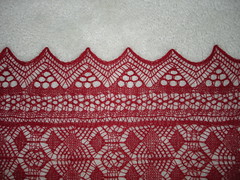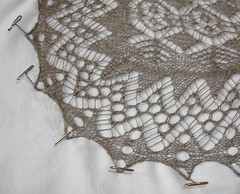Last year I knitted some Orenburg shawls all in a row, so now I feel comfortable assembling shawls in that style: knit a strip of edging long enough to accomodate the main body pattern, then mitre a corner, pick up stitches along the long edge, pick up the cast-on stitches, mitre another corner, and work the body of the shawl and two sides of edging at the same time; then mitre the third corner, knit another strip of edging attaching it to the shawl body as you go, mitre the last corner, and graft the corner stitches together with the leftover edging stitches left in reserve.
There are some advantages to this method. My favourite part is that you don't have to estimate how much yarn you'll need to knit the edging, because all that's left at the end is one side to finish. (If you're keen you can even weigh the first strip of edging after you knit it, make a note of the weight, and knit the shawl's body and side edgings until you have just over that amount left, then knit the top edge. It doesn't work if the whole thing is extensively patterned in an elaborate and carefully thought-out way, but it's dope for plain shawls or ones with a small allover repeating pattern.) My second-favourite part is that you don't have to spend a jillion hours kniting interminable boring edging all the way around after finishing the fun central area. Third-favourite is that edging looks much tidier to me if it is knitted at the same time as the shawl it's attached to.
How do you knit on an edging? My shawls tend to be garter stitch and I worry about binding edges, so I don't slip the selvage stitches. When I'm picking up stitches I pick them up in the "bar", not the "knot", and work shawl body stitches together with the last edging stitch on incoming rows by knitting them together. This is what it looks like:

Which is awfully insubstantial and uneven to boot! I've gotten a better result by picking up stitches all the way around and knitting them through their back loops to yield a crossed pattern, then knitting the edging onto that, but that's an entire shawl circumference's worth of stitches crammed onto a circular needle. Do you know a better way?
Anyway, what I mean all of this to say is that I started a new thing. It will be a stole, constructed inna Orenburg stylee but to look like a Shetland shawl, out of patterns from Heirloom Knitting. The Unst stole made me contemplate wide borders, so this one will be divided into thirds (exclusive of edging), border-centre-border again; all I really have to do is make sure that each pattern element is symmetrical end-to-end. I thought you might want to see a corner:

The trouble with Orenburg shawl construction is that you have to pick up stitches from the edging's starting point, then proceed in the opposite direction. Gossamer Webs suggests beginning with a backward-loop or long-tail cast-on over two needles and slipping a stitch holder or thread through, to work back the other way when you arrive at that point. I wasn't sure about that, because all the edgings in Gossamer Webs aren't patterned at all on even rows, and maybe this type of beginning only looks decent in edgings of this type?
Maybe. I initially thought about casting on invisibly, but doing that means that the edging (1) has a plain row in it, which is obvious and obtrusive in an edging that's otherwise patterned every row; and (2) is offset by half a stitch at that point, which is an occupational hazard of working a piece in two directions. (It doesn't show at all in e.g. stocking stitch, but it's glaring in rib.) I ended up just following Galina Khmeleva's instructions, and it totally worked—there's just an extra thread running through it, but you can't really tell if you're not looking for it, and it takes emphasis away from the offset. Best of all, this method is almost completely hassle-free. I give it my seal of approval.
The yarn is silk and yak, so it is very crisp but with a lovely hairiness that softens the edges of things, so it ends up looking less severe than a silk lace shawl with pointy edging. It's also a funny colour—brown in indirect light but silvery in the sun. All of these are excellent qualities.
No comments:
Post a Comment